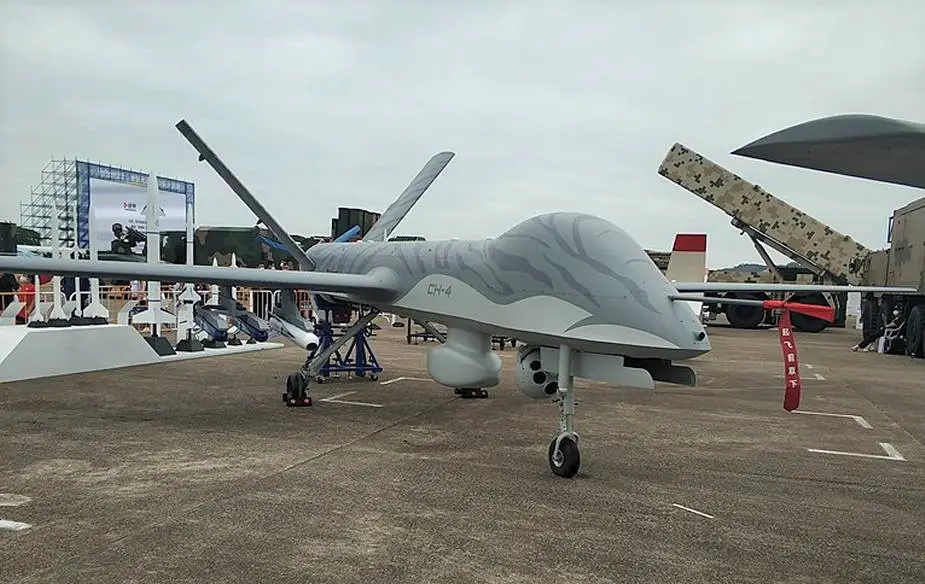Breaking news
Congo armed forces receive 9 Chinese CASC CH-4 Rainbow combat drones.
The Congolese government has acquired nine Chinese-made CH-4 attack drones to combat the M23 rebels in the Democratic Republic of the Congo (DRC), as reported by UASVision and originally published by Lionel Ukele in Military Africa. The CH-4 drones are medium-altitude, long-endurance unmanned aerial vehicles (UAVs) capable of carrying various weapons. This purchase represents a significant advancement for the Congolese military in their fight against the insurgency.
Follow Air Recognition on Google News at this link
 CH-4(D/E) at Airshow China Zhuhai 2022 (Picture source: Wikipedia)
CH-4(D/E) at Airshow China Zhuhai 2022 (Picture source: Wikipedia)
The decision to procure Chinese drones is driven by their affordability and less stringent purchase conditions compared to other options. The CH-4 drones will be stationed at the strategically located South Kavumu military airport, within range of the conflict zone. The initial shipment of three drones has already been delivered, with the remaining six expected to arrive later this year. It is likely that the DRC government has obtained the CH-4B variant, which is a mixed attack and reconnaissance system.
The M23 rebels have been active in the eastern region of the DRC since 2012, where numerous armed groups are vying for control. The deployment of these Chinese-made drones aligns with a trend seen in other African countries, such as Nigeria, Morocco, Egypt, Algeria, and Ethiopia, all of which have chosen to import Chinese military drones to enhance their defense capabilities.
China's increasing influence in the global combat drone market is due in part to its state-funded program aimed at modernizing its armed forces. The Chinese-made CH-4 drone is comparable to the U.S.-manufactured MQ-9 Reaper and has become one of China's top-selling drones. The restrictive export controls imposed by the United States on combat drones have created an opportunity for China to fill the void. Chinese drones offer a more budget-friendly alternative to their American counterparts, making them appealing to countries looking to enhance their defense capabilities.
Overall, the Congolese government's procurement of Chinese CH-4 attack drones demonstrates a proactive approach to addressing the conflict with the M23 rebels. This purchase reflects a broader pattern in Africa, where countries are increasingly relying on Chinese military drones to strengthen their defense capabilities in a practical and economically viable manner.
CASC CH-4 MALE drone
The CH-4 unmanned aerial vehicle (UAV) closely resembles the General Atomics MQ-9 Reaper externally, with the main visual distinction being the absence of a ventral fin below the V-tail on the CH-4. There are two versions of the CH-4: the CH-4A, designed for reconnaissance purposes with a range of 3500-5000 km and an endurance of 30-40 hours, and the CH-4B, which serves as a mixed attack and reconnaissance system. The CH-4B has the capability to carry up to six weapons with a payload capacity ranging from 250 to 345 kg.
One notable feature of the CH-4 is its ability to fire air-to-ground missiles from an altitude of 5,000 meters, allowing the aircraft to stay outside the effective range of most anti-aircraft guns. This positioning also provides a broader field of view for the CH-4 during firing operations.
According to Vasiliy Kashin, a Chinese specialist at Moscow's Centre for Analysis of Strategies and Technologies, the CH-4B UCAV has been exported to several countries including Myanmar, Pakistan, Egypt, Saudi Arabia, Algeria, and Iraq. Additionally, Myanmar has obtained a license to produce the CH-4 UAV domestically, including the transfer of technology.
Technical specifications of the CH-4 are as follows: it has a length of 8.5 meters and a wingspan of 18 meters. The maximum takeoff weight is 1,300 kg, and it has a payload capacity of 345 kg. The CH-4 can endure flights of up to 40 hours and is powered by a single 1,000 Hp engine. Its maximum speed is 235 knots (435 km/h), while the cruise speed is 180 knots (330 km/h). With satellite communications (SatCom), the communication range exceeds 1,000 km (620 mi) (1,500-2,000 km for CH-4B), and it can communicate up to approximately 150 km (93 mi) from the Ground Control Station (GCS).
The CH-4 can be armed with various weapons, including the AR-1 and AR-2 missiles, AKD-10 air-to-surface anti-tank missiles, BRMI-90 90mm guided rockets, FT-7/130 130 kg glide bombs, FT-9/50 50 kg bombs, FT-10/25 25 kg bombs, GB-7/50 50 kg precision-guided munitions (PGMs), and GB-4/100 PGMs.


























